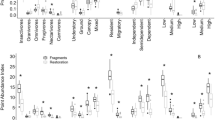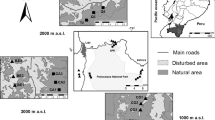Abstract
Although most bird species avoid agricultural areas, nearly a third of all birds regularly to occasionally use such habitats, often providing important ecosystem services like pest control, pollination, and seed dispersal. Combining literature review with large-scale analyses of the ecological characteristics of the world’s birds, I compared tropical bird species that prefer forests, agricultural areas or both, with respect to body mass, diet, range and population size, frequency, conservation status, habitat and resource specialization. Compared to primary forests, species richness of large frugivorous and insectivorous birds (especially terrestrial and understorey species) often declines in agroforests. In contrast, nectarivores, small-to-medium insectivores (especially migrants and canopy species), omnivores, and sometimes granivores and small frugivores do better, frequently by tracking seasonal resources. However, changes in guild species numbers do not necessarily translate to changes in relative abundance, biomass or function, and more studies are needed to quantify these important measures. These findings indicate that the replacement of forests and agroforests with simplified agricultural systems can result in shifts towards less specialized bird communities with altered proportions of functional groups. These shifts can reduce avian ecosystem function and affect the ecosystem services provided by birds in agroforests and other agricultural landscapes.









Similar content being viewed by others
References
Beehler BM, Raju K, Ali S (1987) Avian use of man-disturbed forest habitats in the Eastern Ghats, India. Ibis 129:197–211
BirdLife International (2010) BirdLife’s online world bird database: the site for bird conservation, 2nd edn. BirdLife International, Cambridge
Carlo TA, Collazo JA, Groom MJ (2003) Avian fruit preferences across a Puerto Rican forested landscape: pattern consistency and implications for seed removal. Oecologia 134:119–131
Clough Y, Putra DD, Pitopang R, Tscharntke T (2009) Local and landscape factors determine functional bird diversity in Indonesian cacao agroforestry. Biol Conserv 142:1032–1041
Clough Y, Barkmann J et al (2011) Combining high biodiversity with high yields in tropical agroforests. Proc Natl Acad Sci USA 108:8311–8316
Cockle KL, Leonard ML, Bodrati AA (2005) Presence and abundance of birds in an Atlantic forest reserve and adjacent plantation of shade-grown yerba mate, Paraguay. Biodivers Conserv 14:3265–3288
Faria D, Laps RR, Baumgarten J, Cetra M (2006) Bat and bird assemblages from forests and shade cacao plantations in two contrasting landscapes in the Atlantic Forest of southern Bahia, Brazil. Biodivers Conserv 15:587–612
Fischer J, Lindenmayer DB (2002) The conservation value of paddock trees for birds in a variegated landscape in southern New South Wales. 2. Paddock trees as stepping stones. Biodivers Conserv 11:833–849
Graham CH (2001) Factors influencing movement patterns of Keel-billed Toucans in a fragmented tropical landscape in southern Mexico. Conserv Biol 15:1789–1798
Greenberg R, Bichier P, Sterling J (1997) Bird populations in rustic and planted shade coffee plantations of eastern Chiapas, Mexico. Biotropica 29:501–514
Greenberg R, Bichier P, Angon AC (2000a) The conservation value for birds of cacao plantations with diverse planted shade in Tabasco, Mexico. Anim Conserv 3:105–112. doi:10.1111/j.1469-1795.2000.tb00235.x
Greenberg R, Bichier P, Angon AC, MacVean C, Perez R, Cano E (2000b) The impact of avian insectivory on arthropods and leaf damage in some Guatemalan coffee plantations. Ecology 81:1750–1755
Harvey CA, Villanueva C, Villacis J, Chacon M, Munoz D, Lopez M, Ibrahim M, Gomez R, Taylor R, Martinez J, Navas A, Saenz J, Sanchez D, Medina A, Vilchez S, Hernandez B, Perez A, Ruiz E, Lopez F, Lang I, Sinclair FL (2005) Contribution of live fences to the ecological integrity of agricultural landscapes. Agr Ecosyst Environ 111:200–230
Holbech LH (2009) The conservation importance of luxuriant tree plantations for lower storey forest birds in south-west Ghana. Bird Conserv Int 19:287–308. doi:10.1017/s0959270909007126
Johnson MD, Sherry TW (2001) Effects of food availability on the distribution of migratory warblers among habitats in Jamaica. J Anim Ecol 70:546–560
Johnson MD, Kellermann JL, Stercho AM (2010) Pest reduction services by birds in shade and sun coffee in Jamaica. Anim Conserv 13:140–147
Komar O (2006) Ecology and conservation of birds in coffee plantations: a critical review. Bird Conserv Int 16:1–23
Kupfer JA, Malanson GP, Franklin SB (2006) Not seeing the ocean for the islands: the mediating influence of matrix-based processes on forest fragmentation effects. Glob Ecol Biogeogr 15:8–20
Leyequien E, de Boer WF, Toledo VM (2010) Bird community composition in a shaded coffee agro-ecological matrix in Puebla, Mexico: the effects of landscape heterogeneity at multiple spatial scales. Biotropica 42:236–245
Luck GW, Daily GC (2003) Tropical countryside bird assemblages: richness, composition, and foraging differ by landscape context. Ecol Appl 13:235–247
MacGregor-Fors I, Schondube JE (2011) Use of tropical dry forests and agricultural areas by neotropical bird communities. Biotropica 43:365–370
Manning AD, Lindenmayer DB, Barry SC (2004) The conservation implications of bird reproduction in the agricultural “matrix”: a case study of the vulnerable superb parrot of south-eastern Australia. Biol Conserv 120:363–374
Marsden SJ, Symes CT, Mack AL (2006) The response of a New Guinean avifauna to conversion of forest to small-scale agriculture. Ibis 148:629–640
Martin TG, McIntyre S, Catterall CP, Possingham HP, Tscharntke T (2006) Is landscape context important for riparian conservation? Birds in grassy woodland. Biol Conserv 127:201–214
Mas AH, Dietsch TV (2004) Linking shade coffee certification programs to biodiversity conservation: butterflies and birds in Chiapas, Mexico. Ecol Appl 14:642–654
Mellink E (1991) Bird communities associated with three traditional agro-ecosystems in the San Luis Potosi Plateau, Mexico. Agric Ecosyst Environ 36:37–50
Naidoo R (2004) Species richness and community composition of songbirds in a tropical forest-agricultural landscape. Anim Conserv 7:93–105
Najera A, Simonetti JA (2010) Enhancing Avifauna in commercial plantations. Conserv Biol 24:319–324
Peh KSH, de Jong J, Sodhi NS, Lim SLH, Yap CAM (2005) Lowland rainforest avifauna and human disturbance: persistence of primary forest birds in selectively logged forests and mixed-rural habitats of southern Peninsular Malaysia. Biol Conserv 123:489–505
Peh KSH, Sodhi NS, de Jong J, Sekercioglu CH, Yap CAM, Lim SLH (2006) Conservation value of degraded habitats for forest birds in southern Peninsular Malaysia. Divers Distrib 12:572–581
Perfecto I, Vandermeer J (2008) Biodiversity conservation in tropical agro-ecosystems—a new conservation paradigm. Ann NY Acad Scip 173–200. doi:10.1196/annals.1439.011
Perfecto I, Vandermeer JH, Bautista GL, Nunez GI, Greenberg R, Bichier P, Langridge S (2004) Greater predation in shaded coffee farms: the role of resident Neotropical birds. Ecology 85:2677–2681
Petit LJ, Petit DR, Christian DG, Powell HDW (1999) Bird communities of natural and modified habitats in Panama. Ecography 22:292–304
Pizo MA (2004) Frugivory and habitat use by fruit-eating birds in a fragmented landscape of southeast Brazil. Ornitol Neotrop 15:117–126
Round PD, Gale GA, Brockelman WY (2006) A comparison of bird communities in mixed fruit orchards and natural forest at Khao Luang, southern Thailand. Biodivers Conserv 15:2873–2891
Schroth G, Da Fonseca GAB, Harvey CA, Gascon C, Lasconcelos HL, Izac A-MN (eds) (2004) Agroforestry and biodiversity conservation in tropical landscapes. Island Press, Washington, DC
Sekercioglu CH (2006) Increasing awareness of avian ecological function. Trends Ecol Evol 21:464–471
Sekercioglu CH (2007) Conservation ecology: area trumps mobility in fragment bird extinctions. Curr Biol 17:R283–R286
Sekercioglu CH (2011) Functional extinctions of bird pollinators cause plant declines. Science 331:1019–1020
Sekercioglu CH, Ehrlich PR, Daily GC, Aygen D, Goehring D, Sandi R (2002) Disappearance of insectivorous birds from tropical forest fragments. Proc Natl Acad Sci USA 99:263–267
Sekercioglu CH, Daily GC, Ehrlich PR (2004) Ecosystem consequences of bird declines. Proc Natl Acad Sci USA 101:18042–18047
Sekercioglu CH, Loarie SR, Oviedo Brenes F, Ehrlich PR, Daily GC (2007) Persistence of forest birds in the Costa Rican agricultural countryside. Conserv Biol 21:482–494
Thiollay J-M (1995) The role of traditional agroforests in the conservation of rain forest bird diversity in Sumatra. Conserv Biol 9:335–353
Thiollay JM (2006) Large bird declines with increasing human pressure in savanna woodlands (Burkina Faso). Biodivers Conserv 15:2085–2108
Tscharntke T, Sekercioglu CH, Dietsch TV, Sodhi NS, Hoehn P, Tylianakis JM (2008) Landscape constraints on functional diversity of birds and insects in tropical agro-ecosystems. Ecology 89:944–951
Van Bael SA, Brawn JD, Robinson SK (2003) Birds defend trees from herbivores in a Neotropical forest canopy. Proc Natl Acad Sci USA 100:8304–8307
Van Bael SA, Philpott SM, Greenberg R, Bichier P, Barber NA, Mooney KA, Gruner DS (2008) Birds as predators in tropical agroforestry systems. Ecology 89:928–934
Verea C, Solozano A (2005) Avifauna associated with a cacao plantation understory in northern Venezuela. Ornitol Neotrop 16:1–14
Waltert M, Bobo KS, Sainge NM, Fermon H, Muhlenberg M (2005) From forest to farmland: habitat effects on Afrotropical forest bird diversity. Ecol Appl 15:1351–1366
Wang ZJ, Young SS (2003) Differences in bird diversity between two swidden agricultural sites in mountainous terrain, Xishuangbanna, Yunnan, China. Biol Conserv 110:231–243
Wenny DG, DeVault TL, Johnson MD, Kelly D, Sekercioglu CH, Tomback DF, Whelan CJ (2011) On the need to quantify ecosystem services provided by birds. Auk 128:1–14
Wunderle JM (1999) Avian distribution in Dominican shade coffee plantations: area and habitat relationships. J Field Ornithol 70:58–70
Acknowledgments
I am grateful to Sherron Bullens, Debbie Fisher, David Hayes, Beth Karpas, and especially Kathleen McMullen for their dedicated help with the world bird ecology database. I thank Jason Socci for his help with the figures. I thank Chris Elphick and Mark Wittingham for inviting me to the International Ornithological Congress symposium that led to this paper. I thank the University of Utah for supporting this research.
Author information
Authors and Affiliations
Corresponding author
Additional information
Communicated by Cristina Miyaki.
Rights and permissions
About this article
Cite this article
Sekercioglu, C.H. Bird functional diversity and ecosystem services in tropical forests, agroforests and agricultural areas. J Ornithol 153 (Suppl 1), 153–161 (2012). https://doi.org/10.1007/s10336-012-0869-4
Received:
Revised:
Accepted:
Published:
Issue Date:
DOI: https://doi.org/10.1007/s10336-012-0869-4




